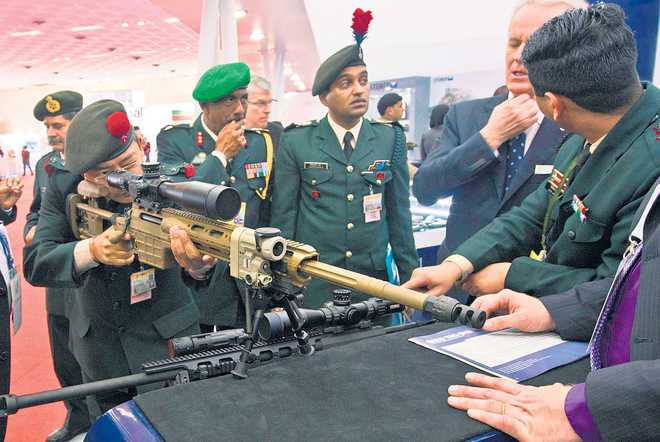FDI conundrum in defence
Bhartendu Kumar Singh
Indian Defence Accounts Service
THE recent revelation that FDI in the defence sector in 2013-17 was just $ 0.8 million or Rs 1.17 crore is shocking since FDI is booming in other sectors and is likely to cross the $ 60 billion figures of 2016-17. While India has put in the appropriate policies to reduce huge dependency on the international arms market and carve out self-sufficiency in defence production through an ambitious 'Make in India' policy, low foreign investments could protract and even derail India's ambitious goals.
The last few years have seen a series of proactive policy initiatives boosting the investment climate in India. These include the totally revamped 'Consolidated FDI policy' in August 2017 allowing 100 per cent foreign investment in most areas through the automatic route. This enables India to increase its share in the global FDI inflow from the present figures of 2 per cent. Similar steps were taken in the defence sector where a liberalised FDI regime was put in place, allowing 49 per cent investment in most subsectors through the automatic route and 100 per cent in select areas after taking request clearances.
But proliferation of initiatives notwithstanding, the FDI in defence is simply not picking off. It would not be proper to put the onus on public policymaking since the same is responsible for the grandiose success in other sectors of economy. The incremental liberalisation of FDI in defence has been a rational choice taken from the alternatives available to our policymakers. The policymakers did take the environmental feedback that consisted of important stakeholders, within and outside the government. These included vital tips from the private sector since the global arms industry is mostly dominated by it.
Perhaps, there is a structural reason that explains part of the anomaly. Leading defence production companies are based in the developed world. According to the latest SIPRI data on arms transfers on this month, the five biggest exporters - the US, Russia, France, Germany and China - together accounted for 74 per cent of global arms exports. Except for China and Russia, the military industrial complex (MIC) of the other three countries is dominated by private sector companies. What binds them together is that they all are loath in exporting technology through the FDI gate; at best, they agree for transfer of technology (ToT) for maintenance. Techno-nationalism explains why they are only interested in exporting arms rather than technology and dither in localised production through joint ventures in host countries. It also explains why the offset portion of eligible contracts goes to peripheral sectors rather than their core areas of production.
Reasons for FDI impasse
The environmental conditions in India also account for the FDI impasse in certain aspects.
1 First, the armed forces have a clear cut preference for imported weapons; they partake of defence PSUs rather reluctantly. The private sector in India is yet to come up to their expectations. Moreover, the indent-based system is largely biased in favour of defence PSUs and creates demand-supply disequilibrium for private sector players.
Since the private sector players do not have an assured future on a par with the defence PSUs, they are yet to forge techno-financial partnerships with foreign firms that could get them the vital investments. In fact, some private players have gone bankrupt, unable to find buyers for their products.
2 Second, the defence PSUs, accounting for 30 per cent of services' weapons requirement, are reluctant players in forging partnerships with foreign players. This despite they being way behind in innovating technology and producing state-of-the-art weapons in most cases. There are ordnance factories that badly need modernisation impetus and status upgradation to retain relevance, but the killer instinct is missing since there is a given assurance of indents, irrespective of quantitative and qualitative shortcomings.
3 Third, defence being a sensitive sector, there was no support for bold changes, akin to other sectors in the early 1990s. The policy preference is for incremental, step-by-step and precautionary reforms. Perhaps, that is why there is no matching response through graduated reciprocation in production (GRIP) by potential foreign investors that still see conservative traits in India's FDI policy.
Policy reforms needed
There is an urgent need to usher in policy reforms and make them more attractive. For instance, can we further liberalise the FDI policy in defence, say 100 per cent investment in automatic route and allow foreign ownership of the invested firms? The revised Technology Perspective Capability Roadmap, published in March, should come as a handy vision document for guiding future areas of investments and technology development. A price preference policy for domestic vendors can also boost the domestic MIC. Most importantly, since foreign investors are shy for the moment, domestic savings and investments can be capitalised and routed to defence production. It would also be prudent to experiment with the two proposed defence industrial corridors and develop them through private investments (including foreign investors) rather than pumping government money or forcing the defence PSUs to cough up.
FDI is symptomatic of a good policy unable to facilitate India's search for home-made weapons. There is, therefore, a need to revisit the entire financing issue of domestic MIC, including the FDI policy, for gradual movement towards self-sufficiency in weapons production.
(Views are personal)










